by Tom Gaylord, a.k.a. B.B. Pelletier
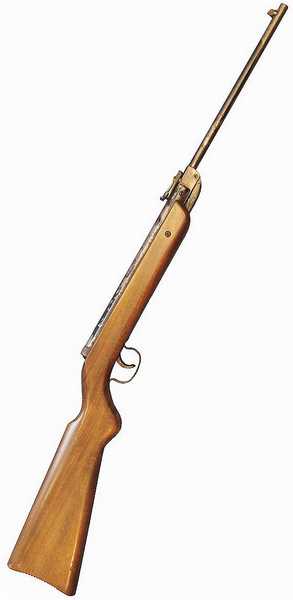
This Diana 23 has led a hard life.
Today, we’ll see how accurate the Diana model 23 is. This report was supposed to be published just before the Roanoke airgun show, but so many things popped up at the last minute and got in front of it that I held off on this one til now.
Before we begin, let me give you a little update on the rifle. At Roanoke, Larry Hannush, the owner of all those beautiful ball reservoir airguns, came over to my table and handed me a brand new barrel for the model 23. He had read that I was going to refinish it with Blue Wonder and he thought a new barrel would shorten my time on the project. In fact the barrel of the gun was the only part where rust had done some more serious work. The old barrel would have either had pits in it, or I would have had to draw-file them out. This new barrel solved a problem for me, so thanks, Larry!
I decided to test accuracy at 10 meters because of the small size of the rifle. I selected 3 different pellets for this test, but none of them was the 7.9-grain Crosman Premier pellet. I would like to tell you why. Crosman pellets are made from a lead alloy that’s hardened with antimony. As a result, their skirts don’t deform as easily as pellet made from pure lead. In a lower-powered rifle like the 23, that means they may not seal all the air behind the pellet.
The second reason I usually don’t select Crosman pellets for guns like the 23 is that they’re often right at or just under the required dimensions. They work very well in repeaters where their smaller size and harder lead are an advantage. In more powerful guns, their skirts can be blown out into the rifling; but in a single-shot spring-piston air rifle of low power, neither of these things is an advantage. So, I seldom select them for guns like the 23.
Now, let’s begin the test. The rifle is rested at 10 meters, and I’m using a classic artillery hold — though as light as the 23 is, it isn’t easy to hold this way. I had to grip it more than I would have liked just to control it.
RWS Hobby flush-seated
The first pellet I tried was the venerable RWS Hobby wadcutter. At just 7 grains, it seemed perfect for the power of the 23. I seated these pellets flush, but as I did something in the back of my mind sent up a red flag. After all the testing of deep-seated pellets in air rifles of lower power, I reckoned I had to come back and also try this pellet seated deep.
Ten flush-seated Hobbys went into a 0.792-inch group at 10 meters. The group looks okay, but it’s a little on the large side — even for shooting a light rifle with open sights.
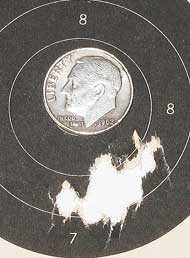
Ten flush-seated RWS Hobby pellets went into 0.792 inches at 10 meters. Not the best group for 10 meters, but a good start.
At this point, I knew I had to try seating these pellets deep in the breech. I was going to give you a link to the one report where I showed that deep-seating improves accuracy with guns of lower power, but some searching turned up about 20+ reports that all show the advantages of deep-seating! That kind of overwhelmed me. I guess I’ve been doing this for a lot longer than I thought!
The next 10 pellets were seated deep into the breech, using the Air Venturi Pellet Pen and Pellet Seater. Of course, you can also use a ballpoint pen to seat pellets; but this seating tool allows you to adjust the depth to which you seat the pellet, and that can be beneficial.
This time, 10 Hobbys made a group measuring 0.52 inches between centers. Not only was it significantly smaller than the first one, the point of impact shifted up about an inch and the group became very vertical. The gun was definitely shooting this pellet differently, and all that had changed was the seating depth.
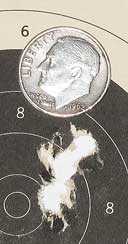
Ten RWS Hobby pellets seated deep into the breech went into 0.52 inches at 10 meters. This is good proof of the need to seat pellets deep in this rifle.
After seeing the results of this test, I decided to seat the rest of the pellets deep. It seems like that’s what the 23 wants.
JSB Exact RS
Next, I tried the JSB Exact RS dome. In the velocity test of this rifle, you’ll remember that this pellet exceeded both the other pellets in velocity and muzzle energy. I was anxious to see how it did for accuracy. This time, I didn’t fool around with flush-seating — I just assumed deep-seating was the way to go. Ten of them went into 0.618 inches.
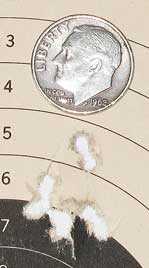
Ten deep-seated JSB Exact RS domes made this 0.618-inch group. It’s not as tight as I’d expected, but it’s still pretty good.
Shooting behavior of the Diana 23
Like I said before, the Diana 23 is a light rifle, and holding it with the artillery hold is difficult. On top of that, add a trigger that breaks at almost 7 lbs., and you can see that I was fighting the rifle’s physical characteristics for accuracy. When I break down the rifle for refinishing, I think I’ll take a look at lightening the trigger. Dropping a few pounds of pull could have a major impact on accuracy.
The rifle does discharge without much vibration. The feel of each shot is very solid and quick.
Beeman Devastator
The last pellet I tried was the Beeman Devastator hollowpoint. I’m aware that Beeman refers to this pellet at a pointed pellet, so I’m showing you an enlarged view here. It sure looks like a hollowpoint to me — and it’s designed to perform like one, too.
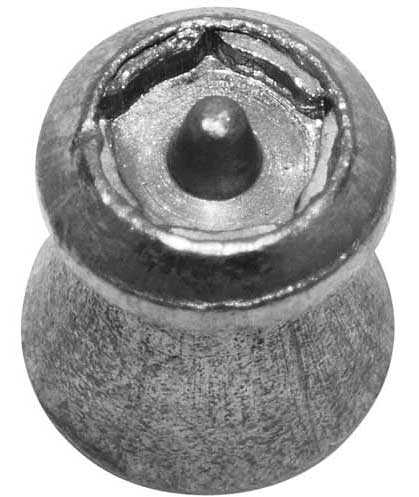
I think the image speaks for itself. The Devastator is a hollowpoint that has a short point in the center. It’s not a pointed pellet.
I decided to try Devastators because of how surprising they were in the Pellet velocity versus accuracy test I did back in December of 2011. They proved that vibration and not velocity alone is what destroys accuracy in a pellet. In this test, 10 deep-seated Devastators made a 0.667-inch group, which is on the high side. I don’t think this is the right pellet for this rifle.
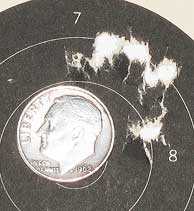
Ten Beeman Devastators went into 0.667 inches at 10 meters. That’s not as good as I would like.
Overall evaluation
I guess I’m surprised by the accuracy potential of this little spring rifle. It looks so small that I thought its performance would also be small. But it wasn’t. Of course, I’ve learned that this one is shooting a bit slow, so maybe there’s even more to see. I think this rifle deserves a 25-yard test before I strip it down and begin refinishing.

B.B.
I’m glad my memory of the accuracy of this little gun was correct. You can be sure to get better with a new mainspring & piston seal. The accuracy will improve with increased power & spin. Also, I remember Dad carefully filed down the trigger mechanism & got a very light let off.Maybe 4 or 5 lbs.
Errol
B.B. and anyone else with an informed opinion,,
I’d like your advice regarding used 10-Meter air pistols for an adult, male beginner. My 27 year old nephew stopped by yesterday and shot my Avanti 747 for quite a while and got hooked. Almost immediately he was shooting tighter groups than I was (ah, youthful eyes and a steady hand!), and from there he improved quickly, getting in about 100 shots. Last night, I reread pt. 7 of your report on 10-meter pistols about ten times, then I skimmed Target Talk (Pilkguns) discussions.
Like everyone, my nephew hates the 747s grips, he knows the trigger could be a LOT better, and he would like easy dry-firing capability. The 747 is accurate, quiet, and easy for him to cock, of course. The Gamo compact is a non-starter as he views Gamo as essentially Mattel or Hasbro. He has intrusted me to point him in a direction, perhaps even select a pistol for him.
I am turned off by the heavy weight, convoluted dry-firing, and (nowadays) high price, even used price, of the IZH-47M, given the used prices for non-PCP German guns. I’m thinking of a used, German, intermediate gun to start with rather than a beginner pistol.
I’m looking at the Diana 6 and 10, and the FWB 65, 80, 103, and perhaps even P35 if it were priced low.
The Diana 10 and FWB 103 are pricey and rare, so I’m thinking Diana 6 or FWB 65/80. How do the Diana 6 and FWB 65/80 compare in handling/accuracy? Just how much better would an FWB P35 be over the Dianas, 65/80 and 103? A 103 would be cheaper than a P35 with pump, and 103s do come up more often than Diana 10s, it seems to me.
My nephew has used my Hill pump to fill my Marauder, and found it pretty easy. Can a pcp pistol be filled with a hand pump?
Also, how is the Diana barrel compared to the FWB? I have experienced a considerable difference in accuracy between higher-end Diana rifles (48 and 52) and FWBs (124) and have come to lean towards FWB with long guns.
Thanks much for your advice,
Michael
Michael,
The Diana and FWB guns (except the 103) you mention are all from the 1960s and 70s and are hopelessly outclassed by today’s standards. Their ergonomics are nowhere near what is available today.
I recommend a used but more modern PCP pistol for your nephew. I shoot a SAM 10, which is made by Morini. That or a Steyr or FWB or Walther or Anschütz would be fine. Just get one a couple generations out of date (the FWB P34, for example) and the price will be affordable.
B.B.
B.B.,
I realize I meant to write FWB P34 above, not P35. Are these small cylinders fillable with a hand pump?
To help him decide if this is something he really wants to dive into, I’m going to lend him my Avanti 747 and a small target trap for a couple weeks, and I gave him a full tin of Hobbies and a pack of Olympic targets. He loves that this is something he could do in his (well, his parents’) basement all winter.
Now I just need to find my old righty grips for the 747, as I am a lefty and he is a righty! (Yes, he was out-shooting me struggling with lefty grips!)
Thanks very much once again,
Michael
Michael,
Yes, the cylinders are filled with a hand pump. If fact, they are very popular among target shooters, because of how fas they fill and how many shots each one gets.
N.N.
Given equal pressures, the size of a PCP tank only determines how long it takes to fill…
From stale memory (I’ve not fired one in over a year, I regret to confess) my Condor runs something like 15 pump strokes per 100PSI. My Marauder takes 10 strokes. My Silhouette pistol takes about 5 strokes per 100PSI.
Presuming the tank is at 2000PSI, the Condor takes 150 strokes to reach 3000PSI. The Marauder would take 100 strokes. And the Pistol would take 50 strokes. (In actuality, my Marauder in factory trim would be pumped up to 2700, and shot down to 2200 — or 50 strokes; I’ve not done power curves with the other two).
Given that — with my AirForce pump (and adapters for the other two), 2000-2500PSI requires body drops with stiff arms; 2500-3000 requires wedging my thumbs against my belt-line, and doing knee bends to drive the pump handle down.
25 hard strokes for the pistol may be more, uhm, comfortable, than 75 hard strokes with a Condor. At the least, one would have a few moments to catch their breath and get back to punching holes in paper much sooner. One doesn’t want to fill a Condor tank and immediately go onto the shooting line — unless one is practicing the the Olympics biathlon (substituting pumping for the cross-country ski phase).
Wulfraed
That is one of the main reasons I got my air tanks and ShoeBox compressor. By the time I got through pumping my guns up. I had to take a break to get back to relaxed breathing.
It is a shame that you don’t care for the 46M. I enjoy mine very much!
Go to PA and look at the Alfa Proj, the Walther LP300 and the Hammerli AP 20. Perhaps one of them will trip your trigger.
BB,
I am learning so much from your blog!
Can you expand on what you consider ‘deep seating’ pellets? I use a pellet seating pen, but only because I don’t like putting my finger in harms way. I have it set to seat just barely past flush. How deep do you push them in?
Randy
Randy,
Welcome to the blog!
I measured it some time ago. The depth differs with each pellet, because their skirts vary on the inside,where the seater pushes. But they go in about 1/8-inch from the rear of the barrel, on average. Of course some barrels are cut on a slant, so one side of the pellet (usually the top) will be deeper than the other side.
B.B.
The little, late model diana’s like the models, 15, 16, 22,23, 25, 27, etc. are among my favorite all day shooters. Keep a sharp eye peeled since these same models were also badged as beemans, winchesters, hy-scores, etc. Power crazed airgunners in the USA have kept the value of most of these models very reasonable.
Most of the time a few drops of silicone oil down the transfer port to rejuvenate the leather seal is all that is necessary to revitalize these guns. Secret #2 is to always try rws superdomes in these lower powered airguns.
ps-the links to part 1 & part 2 of TESTING THE DIANA MODEL 23 are missing.
kevin
Kevin,
Thanks! I’m fixing that right now!
B.B.
B.B.,
No problem. I know you don’t have anything else to do.
kevin
This little gun reminds me of my first springer, a Beeman Silver Bear. Cheap, plastic stocked thing from wally-world, but I’d start with a tin of pellets and after much instinctive shooting being done, I’d look down to see the bottom of the tin staring up at me! Easy to cock, easy to point without looking at the sights, and a heavy, trigger, but all in all, a blast to shot until I broke something in it…. The Diana 23 will probably hold up a lot better over time and is probably a far sight more accurate.
/Dave
A Beeman Silver Bear was my first springer. I think I broke the spring in it. Haven’t got a clue as how to disassemble it.
If I could get it apart, I’d try to replace the spring. But there are no visible assembly screws.
Probably isn’t worth the effort. I think the “pebble finished” barrel is rather unique (that may be a good thing, too).
Les
Same here, Les. I still have it and am still puzzling over how to get the receiver apart without taking a hammer and chisel to it… I only look at it once in a while, but it sits there in the corner and mocks me with what sounds like the same broken spring or maybe spring guide…
Okay, I’m convinced about the seating of pellets after years of skepticism and avoidance. Derrick, in a leisurely and offhand manner, mentioned that there was no reason why my Walther Nighthawk should be having different trigger pull weights with different pellets. He suggested seating them deeper in the clip. I did and problem solved. The Crosman Premiers I had been hoping to try required some considerable force to get them flush which they finally did with a palpable snap. The trigger pull was fine, but the Crosman Premiers shot all over the place. They were astoundingly inaccurate in the gun, but that’s another story.
Gunfun1, actually I think a garden in a farm would be easier to defend even if it were larger. The problem with the old lady I mentioned is that her garden was in town. So rimfire was out. She was hand throwing rocks and using chili powder. Airguns would have been the way for her, but I don’t think she was up for it. Mostly she was trying to drive off the pests with pure hatred.
J-F, don’t know if I quite follow the geometry of your heated pool in winter, but it sounds pretty cool. The other night, I was more aware of the harshness of the environment. It allowed me to play the Navy Seal without really being one. But, you’re right, there’s great potential for enjoyment there too. I was once in a Japanese Onsen which is like a spa that was way up in the mountains. In one area, you could open a sliding door and dart from a enclosed area with heated baths out into the snow into a little heated pool sheltered among some rocks. There you could experience great bliss right in the midst of the hostile elements. You just had to make sure not to do what some noobs did which was to stand undecided in the sliding door trying to decide whether to make a run for it. Another option was to roll out of bed early in the morning and creep your way into the indoor bath. There you could look through an entire glass wall at a stunning panorama of snowy mountain tops turning pink with the rising sun. And while looking at the snow, you would be sitting at ease up to your neck in water almost too hot to bear unless you stayed very still. It got me to thinking that one thing about these cultures which the United States improved upon was a vast old, culture of pleasure. Think of Indian food and Japanese hot baths. People devoted a lot over the centuries to having a good time and came up with all sorts of things. I think we may always be catching up.
JTinAL, thanks for the reference. Was this supposed to encourage me? 🙂 What is most persuasive to me about all this is the complexity of the body. Great strides have been made in understanding it with the scientific approach that looks at the body as a machine. But that approach has built in limitations having to do with oversimplifying. I particularly dislike the repetitive motions of standard weightlifting routines. They will get you immediate results by isolating and building up certain muscles but only at the price of putting the whole system under strain, and more often than not you get repetitive stress injuries. Enter the world of martial arts which treats the body as a complex whole. It sounds like mumbo-jumbo, but you will find that there is deep knowledge coming out when you don’t expect it. Shooting combines these two trends where it is very scientific up to a point with the natural body position and the breathing, but then it seems to get very touchy feely with description of subtle mental states and visualizations to achieve control over the whole system. I’d say that this reference is an eloquent statement on behalf of the Jaws of the Subconscious when a higher power seems to take control beyond what the conscious mind is capable of. On a related note, I will report that my studies with the samurai sword are coming along. Mostly it feels very good, and swinging the 2 pound sword in all different directions beats weightlifting any day for me.
Matt61
Matt61
That little old lady sounds like my Grandma. She was only about 4′-10″ tall. But you better not mess with her.
I remember when I was a kid probably 8 or 9 yrs. old and my dad said something to her (my dad was about 6′-2″ tall) and made her mad. She chased him out of the house and in the yard and she was swinging hard. She was holding on to the straw part of the broom and trying to hit him with the handle. I always listened to her after that.
Here was the thing about her; as much as everybody shot and hunted in the family she didn’t want the guns around her. Maybe the little old lady is the same.
But I agree a air gun would of been the ticket. And that is one of the reasons I still like a pump gun. If you just want to scare your animal away and not hurt it. Put about 2 pumps in the gun and try for the old butt shot to send it running.
GF1
The best way I have seen to keep varmints out of a garden is good old electric fence. You really need one if you have a sweet corn patch. The coons will clean it if they find it. Even though they are a very determined bunch, the zapper will get their attention. They are fast learners.
I have one neighbor who worries about rabbits getting to her garden, but if you knew her …..
The only other problems I have had with a garden other than bugs are the grackles. They seem like to break off the tops of seedlings. I think they are trying to pull them up for a chance to find bugs around the roots.
twotalon
TT
I have tryed scarecrows and fake owls but the grackles just land on or by them and peck at them.
But what I have found that works good is if you get some of them rubber toy snakes from the store.
I use the black plastic zip ties and put a couple on top of the fence post and some actually on the ground by the plants like the snakes are sunning. But you need to keep your eyes open so you don’t end up running into a real one.
Although I did have a Hawk come down once and try to get one of the snakes on the fence post. That’s why I started zip tie-ing them to the post.
B.B.,
I find it very interesting that deep seating the Hobbys not only decreased the group size, but also moved the group up by an inch. Of course, the velocity didn’t change enough to raise the trajectory an inch, so I guess it is all a change in the dynamics of the gun. And you said the 23 was not an easy gun to shoot accurately anyway. I have never seen that sort of variation in PCPs, unless the pellet weights were very different. I can see why some folks who love springers say that shooting PCPs doesn’t take any skill. I don’t think I’d agree with that, but they certainly are easier to shoot.
Lloyd
those beeman devastator pellets make me think about hornady personal defense rounds, a hollow point with a real point in the middle. but I like the d23 , always wanted a small Diana. your lucky that you got a nice barrel for it and will definatly help the restoration bb
Robert w,
I understand the comparison of the beeman devastator pellets to the hornady defense rounds. Similar but different.
The hornady critical defense rounds and hornady critical duty rounds have a flex tip (not integral lead tip like the bee an devastator) similar to and modeled after the hornady vmax, varmint tips.
An analogy in airgun pellets to the hornady personal defense rounds or hornady critical duty rounds would be the jab predators.
IMHO, a closer comparison to the beeman devastators would be crosman destroyers, h & n hollow points, crosman hollow points, jsb stratons, BSA interceptors, etc. Although some of these pellets lack the center “pointy thing” the slight offset of the hollow point design itself will have the same effect on accuracy or lack thereof.
As with hornady personal defense rounds most of these pellets are only accurate at close range. The exception in my personal experience are the crosman hollowpoints IF YOU SORT THEM FOR WEIGHT.
Kevin
Were any of these Diana’s totally unlabelled. I was gifted an an old unlabelled springer with a leather breach seal that looks very much like this rifle. The forearm is slotted and the trigger is single stage and stiff. It has a covered front sight and the exact same rear sight, the cocking arm, trigger…the entire mechanism looks just like this. It is rusted all over, but the bore after the jb paste treatment is a very nice. The stock is broken, but it shoots. This project is beyond my ken. But, perhaps in the future i will have the time and knowledge to treat it right. Again this thing is totally unlabeled. It sure looks just like it though. I was told it is at least 25 years old. Any tell tale marks i can look for?
Pop,
If the gun is totally unmarked, it might be Chinese, Japanese, Indian, South African or even Czech.
B.B.
I have an old Diana mod 23 it has donoi or donor embossed in the left side of the shoulder stock any info on the age of this would be appreciated as I can’t find any pics with the same stock
Cam,
It’s impossible to say for sure without the date stamp that’s on the left rear of the spring tube.
B.B.
I have one of these my father brought over from England in the 60s and I shot for years. Found it in a coat closet after nearly 20 years. It is in need of some TLC and repair, the latch mechanism doesn’t hold the spring and a few other tweaks, Anyone know of a repair shop in the US? A few places I’ve called in Southern CA say parts aren’t available.
L. Walton,
There parts are available, if you know where to look. This man probably has what’s needed and he can rebuild your rifle for you:
B.B.
Thanks for the quick reply! Just sent him a note.